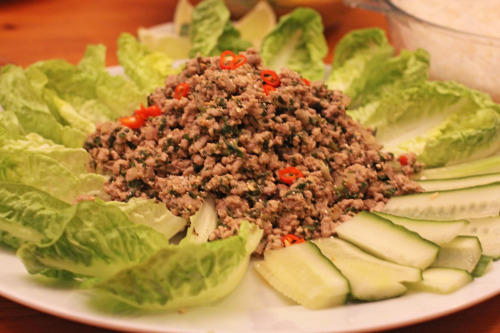Larbilicious
 Monday, February 7, 2011 at 10:00PM
Monday, February 7, 2011 at 10:00PM 
One of the nice things about writing this blog is that I find out a lot of interesting things in the process. I have been making larb for years – it is a staple canapé for our annual Christmas Eve party and Dad entrusted me with it early on because it is extremely easy. I have always thought it was ubiquitous in Thai cuisine, just as it is in Sydney’s Thai restaurants, but I have just discovered that it is actually a regional dish from Isan, in north east Thailand, and probably originated further afield. In his book, Thai Food, David Thompson shares some theories on the salad’s historic origins:
A larp is an ancient salad. Some argue that it has the same origins as steak tartare, raw meat eaten with onions. The merchants of this part of Asia, the Haw, may have helped to spread the dish from the south-west of China and now, throughout northern Thailand, there are adaptations of this style of salad.
Wikipedia suggests that larb may have come to Thailand from Laos:
Laotian cuisine has strongly influenced the neighboring cuisine of Northeastern Thailand (Isan) ... The most famous Laotian dish is Larb ... a spicy mixture of marinated meat and/or fish that is sometimes raw (prepared like ceviche) with a variable combination of herbs, greens, and spices.
Leaving aside the steak tartare idea, which would have come from the French colonists rather than the Haw, these two suggestions make sense together when you consider the geography of the region; Laos is bordered by China in the North and Thailand to the South East.
The version that Dad and I make is cooked over heat rather than by marinating in the citrus dressing (which is not technically ‘cooking’ but has a similar effect). Once upon a time we used David Thompson’s recipe but, as these things have a tendency to do, it has evolved over time. Nonetheless, there are two elements of Thompson’s recipe which I have always stuck to.
Firstly, I always cook the meat in a small amount of stock, rather than oil. Apart from the fact that this a healthier option, it ensures that the meat does not brown, instead remaining moist and tender, as it would if it had simply been marinated.
Secondly, I always add a tablespoon of ground, toasted rice; this is always included in traditional recipes for larb, but is sometimes omitted in western restaurants or by lazy chefs (read Hash Brown). The toasted rice adds a wonderful nutty flavour to the dish and helps to bind the salad.
I usually make larb gai (chicken) or larb moo (pork) because I think it works best with white meat; light and refreshing. For this reason, I am also keen to try it with fish. I am not so fond of beef or duck larb, which I find too heavy, but a similar dish called nuea yang nam tok (grilled 'waterfall' beef) made with strips of rare beef rather than minced beef is delicious.
This recipe will serve four to six people as part of a traditional Thai meal, i.e. alongside several other shared dishes. Traditionally, it is served with two or three raw vegetables and steamed rice. I don’t serve it with rice everytime, but always with lettuce leaves (try baby gem or trimmed iceberg leaves) and strips of cucumber. To do it as a canapé simply spoon the salad into the lettuce leaves or serve on betel leaves, if you can source them.
Ingredients
Method
In a large pan or wok, heat the stock with the sugar. When it is simmering, add the meat and stir continuously. When the meat is almost cooked, add the shallots and cook until the meat is just done.
Remove from the heat and season with the lime and fish sauce; if the sauce is too sour, add some more fish sauce, if it is too salty add more lime. Next add the chilli powder, and again adjust as necessary.
Stir through the coriander and mint, as well as half of the toasted rice. Garnish with the remaining rice and the red chilli slices.
 Vix |
Vix |  2 Comments |
2 Comments | 
Reader Comments (2)
I am thrilled to find your recipe. I had Larb last night and was going to look for a recipe today anyway. i appreciate your notes and thoughts about variations.
Hi Amyarizona, glad to be of help. I too enjoyed finding out about the history and variations.